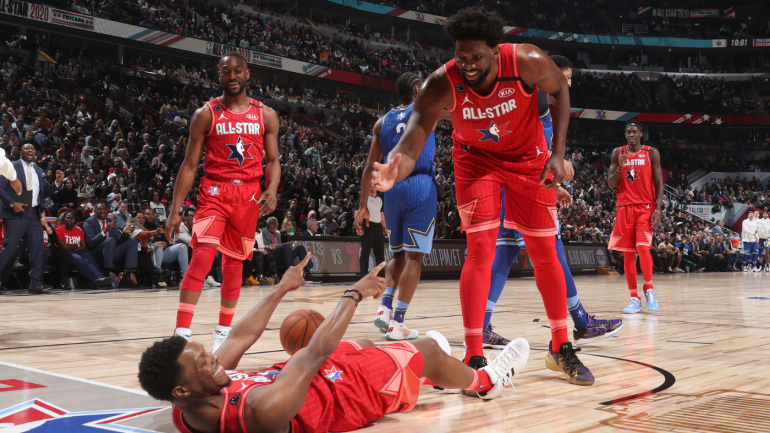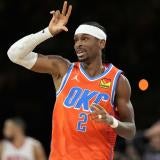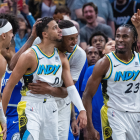
When Fred VanVleet hit a 3-pointer to cut the Toronto Raptors' deficit from 14 points to 11 against the Philadelphia 76ers last Tuesday, there were 58.7 seconds on the game clock. The rest of the contest lasted almost 18 minutes in real time, thanks to a parade of free throws, timeouts and a replay review. For the same reasons, when a 3-pointer from Wisconsin's D'Mitrik Trice cut Illinois' 12-point lead to nine with 2:09 on the clock last Saturday, it took 22 minutes to reach the final buzzer.
These games prompted Jeff Kerr, an NFL writer for this website, and John Gasaway, a college hoops writer for ESPN, to invoke Nick Elam's name on Twitter. I've done it, too, after watching games deteriorate into intentional-foul fests broken up by interminable replays.
I've never loved drawn-out finishes, but before Elam and his eponymous Ending came along, I'd never thought much about the way the running clock distorts strategy. Now I find it more frustrating when teams stall to protect a lead, foul to extend the game and launch hopeless, contested 3s out of desperation.
This is the curse of the Elam Ending. Once you see it in action, you can't unsee it.
"It sounds like you might be experiencing what I've experienced all along," Elam told me. "I might call it a curse, but I actually think it's kind of fun. Since 2007, every single basketball game that I watch -- and I watch a lot of them -- just in the back of my mind I think how it would have played out differently with the Elam Ending. And I can't shake that. I don't really try to shake that."
Who wins the 2021 NBA All-Star Game? And what crucial X-factor makes one side of the spread hit hard? Visit SportsLine right now to see which side is a must-back on Sunday, all from the SportsLine expert on an impressive 35-23 NBA run, and find out.
One could frame this as a byproduct of the Baader-Meinhof phenomenon, a.k.a. the frequency illusion: When you learn about something new, you suddenly see it everywhere. But is your mind really playing a trick on you if needlessly warped crunch-time situations are everywhere? According to Elam's research, late-game deliberate fouling occurs in approximately 44 percent of NBA games and 58 percent of NCAA games, and it results in a comeback victory roughly 1 percent of the time. Getting rid of the clock and playing to a target score eliminates this.
Elam came up with the concept in 2007, saw it come to life at The Basketball Tournament in 2017 and watched it go mainstream at the 2020 NBA All-Star Game. A couple of weeks after that, during an appearance on Fox Sports' "First Things First," then-Houston Rockets general manager Daryl Morey said he thinks the NBA will adopt it for overtime "in the next few years."
Morey also lamented having to endure all the timeouts and fouls down the stretch of Houston's game the previous night. In the closing moments of the second exhibition game of his tenure as the president of the Sixers, Morey tweeted in favor of implementing the Elam Ending for the preseason. Elam is filled with a mix of hope, pride and relief whenever he notices such endorsements, even when they come from people without the public profile of a top-tier executive. It is distinctly reaffirming every time he hears an "old-school" basketball lifer -- say, a longtime high school coach -- echo his argument that the Elam Ending produces a more fundamental, natural style of play.
Before this week, the last time I'd spoken to Elam, he was about 48 hours from his idea's All-Star debut and sounded a bit nervous about the NBA's decision to play an entirely untimed fourth quarter with a plus-24 target score. "I was way wrong about that one," he said. The 24 points were "definitely" sufficient in that game, and, throughout the whole fourth quarter, the atmosphere in the United Center was "exactly what you would want to see and feel in any basketball game."
Whenever his project reaches a milestone, Elam reflects on how far it has come and thinks about the possibilities that might lie ahead. "Seeing how well it works at the All-Star Game, I knew that the idea was going to continue to grow throughout the basketball world in some way and keep moving forward," he said. "And that's been my goal every day for almost 14 years now."
In July, weeks before the NBA descended on Disney World, TBT took over a hotel in Columbus, Ohio, and set up the first basketball bubble. This iteration of the tournament featured a slight change to the Elam Ending, originally suggested by a fan named David Frohardt-Lane in 2018: Any defensive foul committed in the penalty would lead to the offensive team getting one free throw and possession of the ball, rather than the standard two free throws. This erased the incentive for teams to intentionally foul when the opposing team is exactly three points from the target score.
This "worked beautifully," Elam said. With a trip to the championship game on the line, under the old rules, Overseas Elite might have taken a foul when Sideline Cancer was a 3-pointer away from a victory. Instead, guard Maurice Creek hit a stepback 3 and delirious teammates piled on top of him. Elam noted that nobody had to wait around for the referees to review how much time was left, which he called an "under-discussed benefit" of the format.
"As far as tweaking of the idea in TBT's setting, I think we are at a good stopping point," Elam said. "When we go into 2021 at TBT, this will be the first time that we haven't made any tweaks, major or minor, to the Elam Ending at all. It's going to be the same version that we saw in 2020. That fine-tuning process was necessary. I think we've got it in a place that we really like."
Eleven days after Marquette alumni team Golden Eagles won the 2020 TBT title, the Elam Ending went north. In St. Catharines, Ontario, at the Canadian Elite Basketball League's "summer series" tournament, the format was used in FIBA competition for the first time.
"To have a foot in the door of the international basketball scene is really exciting," Elam said. "It's hard to tell what country is going to be next and when and all that, but that's a really important step for this concept. That's something all along I thought was going to be an important milestone was getting into the FIBA world."
Elam dissected the final stretch of all 26 CEBL games the same way he does TBT games. He looked at, among other things: the offensive efficiency during the Elam Ending compared to the offensive efficiency in the timed portion of the game, the type of shot that ended the game, the number of timeouts, game time elapsed and real time elapsed. Every sudden-death possession requires a detailed description. He also likes to watch the two minutes before the Elam Ending to see if the leading team tries to slow the game down and if the trailing team ramps up the pressure on defense. Elam thinks the latter should happen more often.
When the 2021 CEBL season tips off in June, it will bring back the Elam Ending. Less clear, however, are the NBA's plans for it. Could we see it in summer league or the G League soon? Would another wildly competitive All-Star Game finish make a difference?
Elam's communication with the league is "still a little more one-way than I would like," he said. But he's "staying positive and patient and persistent and gracious with all that, and, hopefully, eventually, I will get a seat at the table." The NBA does not call its All-Star Game format the Elam Ending, but it has not created a new name for it, either.
"I advocate for myself as much as I can," Elam said. "The NBA is well aware that I'd like to see that name continue to be in use. It'll be interesting to see how many times the phrase Elam Ending is actually uttered during Turner's broadcast on Sunday. I put the over-under at about 0.5. I'd be thrilled with an over there."
Any of us can toss around half-baked ideas to improve the game. The vast majority of us will not come up with something that actually works and dedicate ourselves to spreading its gospel. "I treasure this pursuit," Elam said, partially because he believes in diversifying his "portfolio of happiness." Between friends and family, his professional life -- Elam is a professor at Ball State, a part-time Cincinnati Reds groundskeeper and a former middle-school principal -- and "this basketball project, which has kind of been the wallpaper of it all, anytime I'm having a bad day in one realm, I can draw happiness from some other realm," he said.
His idea has gone from a PowerPoint presentation to one of the biggest stages in basketball, but he has relatively little control over where it goes next. Hours after getting off the phone with me, he appeared on NBA TV and repeated a point he'd made: In the 2020 All-Star Game, the players' intensity and effort, especially on defense, made it special. The format did not force them to play their hearts out. Left unsaid was the fact that, if Sunday's game is less thrilling, it is not the Elam Ending's fault.
Looking back, Elam wonders where his drive, the energy and optimism came from when he was 24 years old, sending his research to anyone he could find in the basketball world.
"I didn't know it at the time, but it was a long way from getting anywhere, from making any sort of progress," Elam said. "And I kept at it all the time. And I can honestly say this is something that I have thought about for at least part of a day, every single day, since March 10th, 2007. That is not an exaggeration."
The long road Elam has taken has reinforced the value of staying positive, patient and persistent. He understands that, for people who run basketball leagues and events, implementing the Elam Ending is a bold move that could put their livelihoods on the line. He doesn't begrudge anyone for taking baby steps or letting someone else be the guinea pig. Elam's experience as a principal taught him to take criticism graciously, a valuable skill when undertaking any ambitious endeavor. Four years ago, he told ESPN's Zach Lowe that his greatest fear is someone else running with his idea and leaving him behind. "There's still a possibility that that could happen," he said, but he is cautiously optimistic that it won't.
For an entire decade, Elam was the only person speaking on behalf of his concept. TBT allowed it to speak for itself. Now that his gospel -- or his curse -- is spreading, it is easy to find motivation. "I've seen the progress," Elam said. "And it seems like the breakthroughs are really that much more imminent and on the horizon." The day that the NBA announced that the format would return for Sunday's game, Elam edited his Twitter bio to read, "2-Time NBA All-Star. Basketball's future norm."

















